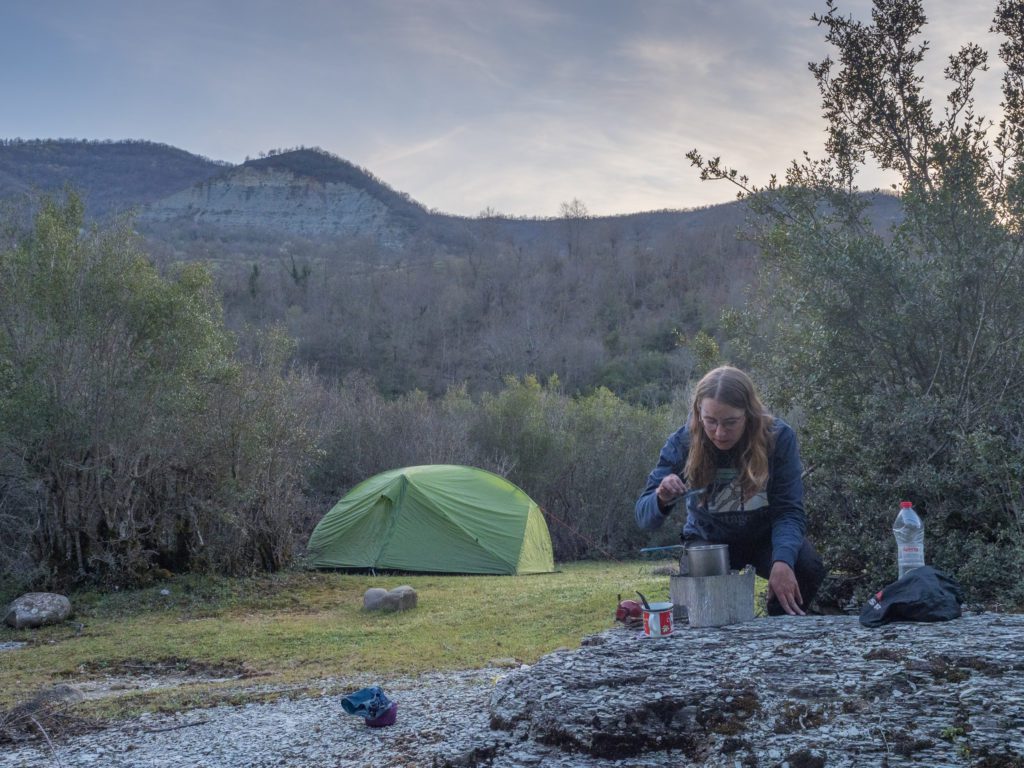Bicycle touring and bikepacking allow you to experience the freedom of the open road while immersing yourself in the great outdoors. To feed yourself during your bicycle adventure, you will need a reliable camping stove to prepare meals. But what camping stove is best for bicycle touring and bikepacking?
In this article, I’ll explore the advantages and disadvantages of various kinds of camping stoves: gas stoves, alcohol stoves, and multi-fuel stoves. Hopefully, this breakdown of their features and characteristics will help you choose the best camping stove for your bicycle adventure.
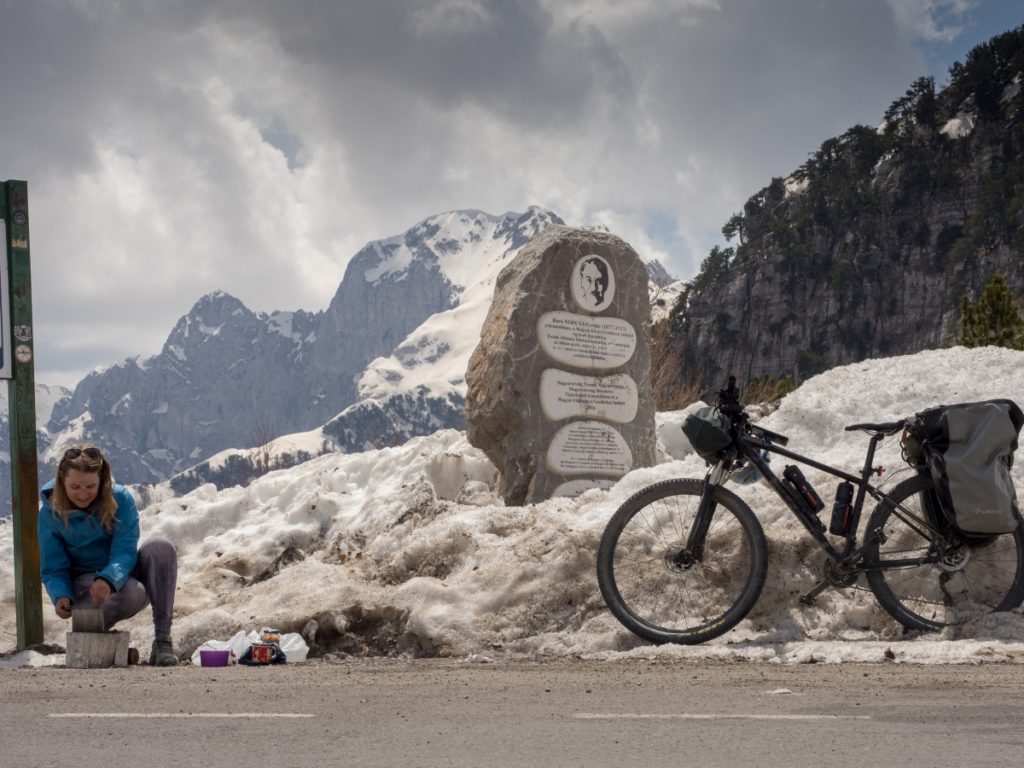
How to choose a camping stove for bicycle touring?
You need to ask yourself a few questions before deciding which type of camping stove is the best for your needs. There is no one-size-fits-all. Here are the most crucial factors you have to take into consideration before buying a new camping stove:
- Where will you travel? The availability of certain kinds of fuel varies from country to country. It also depends on how remote the regions you will cycle through are. Will you cross high mountains or travel in low temperatures? Will it be easy to find outdoor stores or hardware stores?
- How long will you travel? For example, gas stoves are a perfect option for a short trip or a weekend overnighter close to home. However, if you travel by bike for months or years, other stove types will probably be a more reasonable option.
- What, how often and for how many people will you cook? These factors will affect how much fuel you need and how efficient your cooking set should be. Some people only use the camping stove in an emergency to boil water for an instant meal. Others embrace the art of cooking outdoors and will need a more convenient and efficient stove.
Gas stoves – most convenient
Gas stoves are a popular choice for camping. Nothing beats them in terms of ease of use and portability. Last year, when travelling in Romania, I used my dad’s gas stove instead of my usual petrol stove, and it felt like so much less hassle!
These stoves typically use small propane or butane canisters. You can buy them at outdoor stores or camping supply shops.
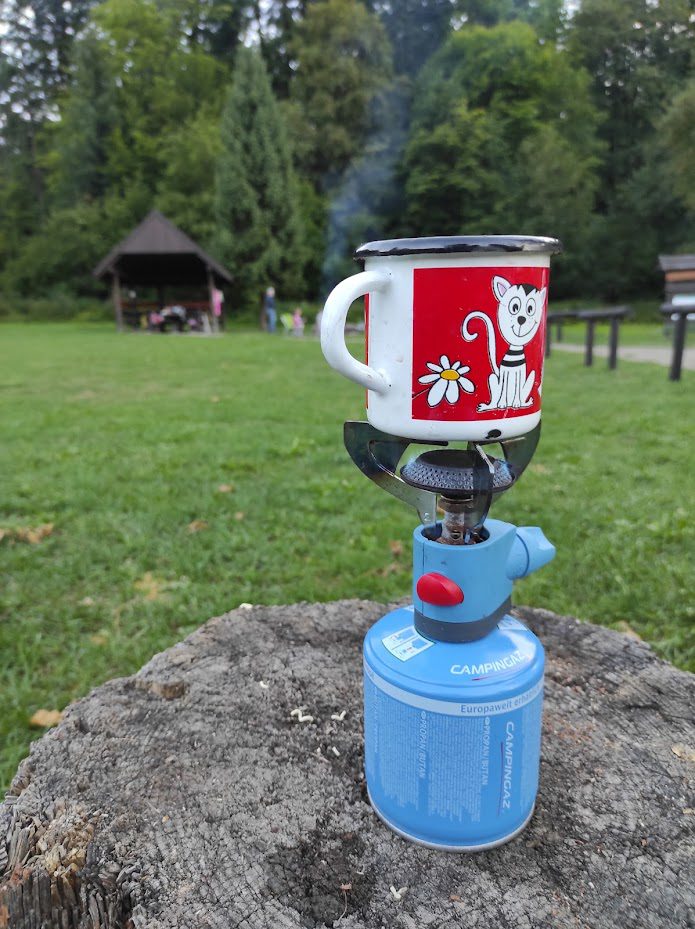
They are perfect for short trips and travelling around Europe and North America. You shouldn’t have problems finding them in the Himalayas and Patagonia. However, getting a spare canister might be more challenging in other regions.
You cannot bring a gas canister on the plane, so if you’re flying with your bike, ensure you can get the right canister type at your destination.
If you plan to travel through remote areas and cross many countries, a gas stove won’t be the best choice.
Advantages:
- Lightweight and compact (the stove itself takes barely any space).
- It’s quick and easy to set up (there’s no need to preheat or assemble, as you can connect the canister with one click).
- You can easily adjust the flame.
- Clean and almost no smell.
- Can safely be used indoors.
Disadvantages:
- Finding replacement canisters can be challenging in certain regions.
- It’s difficult to dispose of canisters responsibly when travelling long term.
- The canisters are relatively expensive compared to other types of fuel.
- Canisters add weight to your gear, especially on long trips.
- Figuring out how much gas is left in your canister can be tricky. It happened to me a few times that I ran out of gas unexpectedly.
- Gas stoves don’t work well in low temperatures and at high altitudes.
The best gas stoves for bicycle touring

Campingaz Twister Plus
Campingaz Twister Plus is a compact and light (263 g) camping stove. I used it during many European bicycle tours when I didn’t need a multi-fuel stove. It is extremely easy to use and I never had any issues with it. It runs off Campingaz CV300 Plus and CV470 cartridges that are widely available in Europe (you can easily find them in Decathlon and in many hardware stores.

MSR Pocket Rocket Deluxe
MSR Pocket Rocket Deluxe is the perfect choice if you have a few extra bucks and are looking for an ultralight camping stove. With only 83 g, you will barely notice its weight in your panniers. The producer recommends using it with MSR IsoPro canisters, but it also works with other canisters with a screw-on Lindal valve.

Soto Amicus
The Soto Amicus camping stove perfectly compromises the price and weight (76 g is almost nothing!). The only downside is that larger pots can be a bit unstable (but you probably won’t carry big pans and pots on your bike anyway!).
Multi-fuel stoves / liquid fuel stoves – most versatile
Multi-fuel stoves are the most versatile option. With them, you won’t have to worry about fuel refill, even when travelling through the wildest corners of the world.
Most liquid fuel stoves run on white gas (aka Coleman fuel), kerosene (in some countries sold as paraffine or lamp oil) and regular petrol. When I cycled through Kyrgyzstan, finding an outdoor store with gas canisters was nearly impossible, and even hardware stores were rare in the mountain areas. But there was always a gas station where I could fill my bottle with petrol.
Nevertheless, remember that regular car petrol is not pure and can easily clog your stove (especially if it’s low quality). That’s why regular maintenance is necessary.
Advantages:
- Reliable performance in various weather conditions and altitudes. Multi-fuel stoves work better when it’s windy and high in the mountains.
- They are perfect for long trips thanks to efficient fuel consumption.
- Whenever you cycle, you will always find fuel for the multi-fuel stove.
- Some models even have an adapter to use with a gas canister.
- If regularly maintained, they are very durable.
Disadvantages:
- The setup is much more complicated than with gas stoves.
- The stove is bulkier and has more parts.
- You need to clean it regularly to avoid clogging.
- It takes a while to preheat the stove.
- The fuel is more stinky (especially kerosene and low-quality car petrol).
- It’s dirtier than a gas stove, sometimes leaving soot on your pots.
- Most multi-fuel stoves are more expensive than gas stoves and alcohol stoves.
- Not all multi-fuel stoves run on all kinds of liquid fuel (mine, for example, doesn’t run on diesel). Read the instructions carefully to see what fuel you can use with your stove.
- It shouldn’t be used indoors due to fire hazards.
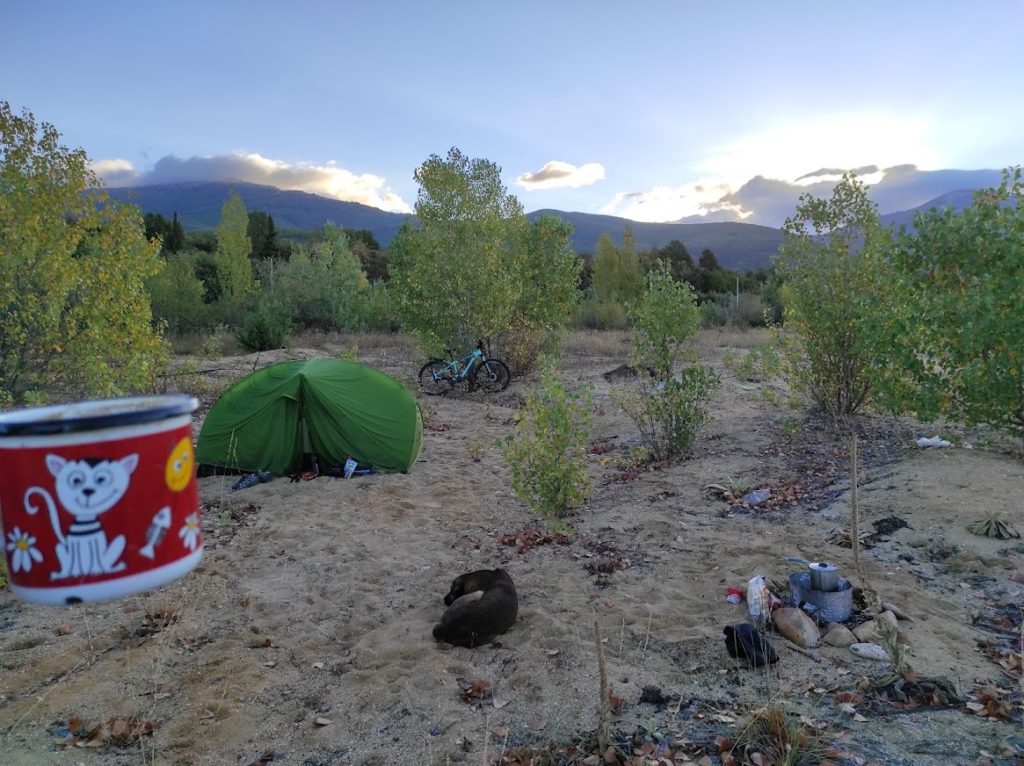
The best multi-fuel stoves for bicycle touring
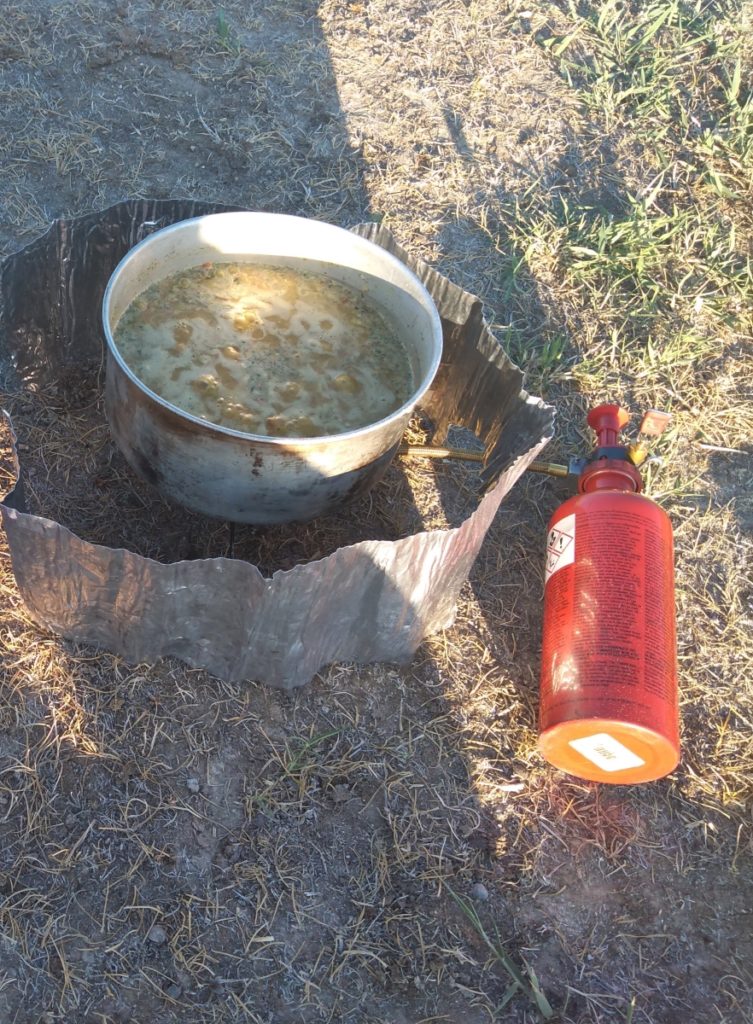
MSR Whisperlite International
One of the most reliable camping stoves, MSR Whisperlite International, is a safe choice for travellers cycling through remote landscapes for long months. I’ve been using it for four years now, and it has never let me down (except for getting clogged in Kyrgyzstan, but that’s on me—I should’ve known to clean it more regularly when using dirty Kyrgyz petrol). It runs on white gas, kerosene, and petrol.

MSR Whisperlite Universal
One to rule them all. If you cannot decide between a gas stove and a liquid fuel stove, the MSR Whisperlite Universal stove is a perfect choice. It is a bit heavy (453 g) and quite pricey, but at least you don’t have to worry about fuel availability anymore, as it runs on all kinds of fuel except alcohol.
Bonus: the names of different types of fuel in different languages
The tricky part of using a liquid fuel stove is the confusion about the names of different fuel types in other languages. Even in various English-speaking countries, the same substances can be known under different names (what the Americans call white gas or Coleman fuel, the Australians know as Shellite).
I put together a table of fuel names in 17 languages. If you have ever spent too much time trying to figure out how to ask where to buy kerosine or white gas in Russian or Arabic, hopefully, this table will make your life easier in the future. You can find it below or download it as a pdf.
If you know what white gas, kerosene, or white spirits are called in other languages, don’t hesitate to share it in the comments!
| English | White Gas/ Coleman fuel/Shellite / pure Benzin | Kerosene/ paraffin/ nafta | Diesel | Automobile gas/petrol/gasoline | Mineral spirits/ white spirits |
| Arabic | كيروسين (kyrusin) | ديزل (وقود) (dizil (wqudi)) | وقود السيارات (waqud alsayaarat) | ||
| Bulgarian | Ekstraktsionen benzin | парафин (paraffin) керосин (kerosene) | Diesel/ Дизелово гориво | Spirt | |
| Chinese | 去漬油 (Qù zì yóu) | 煤油 (Méiyóu) | 柴油 (Cháiyóu) | 汽油 (Qìyóu) | 礦物油 (Kuàngwù yóu) |
| Czech | Technicky benzin | Petrolej/ Parafin | Diesel/ Motorová nafta | Benzín | Denaturovany lih/ denaturovany alkohol |
| Dutch | Wasbenzine | petroleum/ lampenolje | Diesel | Loodvrije benzine | |
| Danish | Renset benzin | petroleum | Diesel | Benzin | Sprit |
| French | Essence “c” | petrole/ lampante | Gazole | Essence normale/ Essence sance plomb | Espirit-de-vin/ alcool |
| German | Reinigungsbenzin, Kocherbenzin, Fleckenbenzin | Petrol | Diesel | Superbenzin (bleifrei Benzin) | Spiritus |
| Italian | Benzina bianca | kerosene | Gasolio per autotrazione | Benzina per autoveicoli | |
| Japanese | 灯油 (Tohyu) | 軽油 (Keiyu) | ガソリン (Gasorin) | ||
| Norwegian | Renset bensin | Parafin/ Tennveske /lampeolje/ fritidsparafin | Diesel | Bensin | Rødsprit/ mineralterpentin/white spirit |
| Polish | Benzyna ekstrakcyjna | Nafta | Diesel/ olej napędowy (ON) | Benzyna bezołowiowa | Spirytus, alkohol metylowy |
| Russian | Галоша (Galosha) | Кероси́н (kerosene) | дизель (diesel) | Неэтилированный бензин (Neetilirovannyy benzin) | спирт (spirt) |
| Spanish | Bencina blanca, Solvente bencina, Gasolina blanca | Keroseno, Oetroleo | Gasoleo automocion | Gasolina automocion | Disolvente |
| Swedish | Ren bensin, Industri bensin | Fotogen | Diesel | Bilbensin/ blyfri bensin | T-röd |
| Turkish | Benzin | Kerosen | Dizel | Benzin | Beyaz ispirto |
Alcohol stoves – the cheapest
Lightweight and compact alcohol stoves are another popular choice among backpackers and bikepackers. If your main criterium for choosing your gear is the price, an alcohol stove will be a tempting option. You can even make one yourself, using just a beer can!
There is one caveat. Cooking on an alcohol stove is pretty slow. If you’re impatient, like me, and want your dinner ready in 10 minutes, you should get a different stove for your bicycle tours.
Remember that the alcohol you’ll use for cooking has to be at least 90%. The higher precentage of alcohol, the better.
Advantages:
- Lightweight and compact, perfect for minimalist bikepacking.
- You can buy high-percentage alcohol in hardware stores in most countries.
- Simple construction, DIY options.
- Minimal maintenance.
Disadvantages:
- Slower cooking time.
- Limited fuel availability in remote areas or countries with alcohol restrictions (some Muslim countries).
The best alcohol stoves for bicycle touring

Trangia Spirit Burner 602500
The Swedish brand Trangia is the most known producer of alcohol stoves. If you’re on a budget and plan to cook only occasionally, Trangia Spirit Burner is a decent camping stove for your cycling adventures. Its simple construction, compact size and the possibility to use it with solid fuel tablets make it a great choice for people who don’t want to spend more than 20 euros on the stove.
